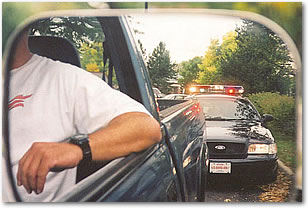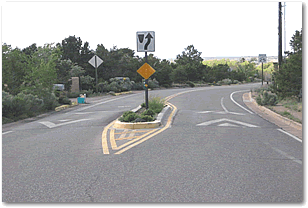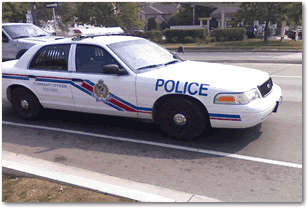|
|
 A
quick check of the rearview
mirror and all you see
are flashing lights.
Oh Oh...here it goes.....Your
heart races and sweat
forms on your brow as
the realization sinks
in. You were speeding
and this time it could
be expensive. Just as
your foot reaches for
the brake pedal, the
police officer pulls
out and accelerates
past. His target is
someone else today,
but next time it could
be you. AND this will
increase you Insurance
rates after 2 tickets.
Think Ahead...be careful...there
is no rush. But here
are a few ideas. A
quick check of the rearview
mirror and all you see
are flashing lights.
Oh Oh...here it goes.....Your
heart races and sweat
forms on your brow as
the realization sinks
in. You were speeding
and this time it could
be expensive. Just as
your foot reaches for
the brake pedal, the
police officer pulls
out and accelerates
past. His target is
someone else today,
but next time it could
be you. AND this will
increase you Insurance
rates after 2 tickets.
Think Ahead...be careful...there
is no rush. But here
are a few ideas.
We
all have faced this
situation at least once
in our lifetime. Convinced
we are not at fault,
the relief of not being
pulled over is as equally
heart stopping as the
realization we were
guilty. Here are several
tips to help you stay
on the good side of
the law.
-
How fast is too
fast? Generally
speaking, police
officer's will allow
between 9 and 15
km's over the posted
speed limit. Anything
above this and you
are at the mercy
of the local or
provincial police
department. Insurance
rates also soar
for any speeding
violation 20 km's
over the limit.
-
Drive
appropriate for
each situation.
If you are in a
20 km/h school zone,
limit your speed
to what is posted.
When it comes to
areas where children
may be playing or
crossing on a regular
basis, the police
have no reason to
be tolerant of speeders.
If your child was
crossing the street
and someone decided
to speed through
the area, how lenient
would you be?
- Traffic
flow is important,
so try not to stand
out from the crowd.
Use cruise control
when driving on
the highway. By
maintaining a level
speed, even if it
slightly exceeds
the posted limit,
police are less
likely to notice
your vehicle. Keep
pace with other
vehicles around
you. If someone
is riding your tail
and wants to pass,
let them go. Never
be the quickest
person on the road.
Let that dubious
privilege fall to
someone else. In
addition to maintaining
a steady speed,
fuel savings provided
by cruise control
can be substantial.
- Watch
your surroundings
and oncoming traffic
for signs of police
activity. Back in
the day, it was
common for drivers
to signal approaching
traffic of potential
roadblocks and speed
traps by flashing
their headlights.
Today, most drivers
are content to let
others take the
fall instead. Something
about morbid curiosity
I guess. That said,
a small number of
driver's will flash
their headlights
to warn you, so
take note and maintain
the appropriate
speed when this
happens.
-
Learn
where police choose
to lie in wait on
well travelled routes.
Be alert as patterns
will develop based
on traffic flow,
speed limit changes,
etc. Favorite places
include overpasses,
"emergency
vehicle only"
crossroads and on-ramps
to the highway.
Pay attention as
you drive back and
forth to work on
a daily basis and
watch your speed
closely.
-
In
almost all of Canada,
radar detectors
are illegal. Transport
truck drivers employ
CB communication
to learn where speed
traps are. Following
behind a truck at
a safe distance
is a less costly
way to achieve similar
results to a radar
detector.
- When
a police officer pulls
you over, they generally
have three options
available; offer a
warning, write a ticket
or arrest you. Option
number three is something
you definitely want
to avoid.
 If
you are stopped by the
police, pulling off
to the side safely and
as soon as possible
are sure ways to let
the officer know you
respect their authority.
Pretending you didn't
notice them in your
rearview mirror and
extending the "chase"
is never a good idea.
Provide enough space
for the police officer
to approach your vehicle
without the need for
concern of oncoming
traffic. Turn on your
four-way flashers as
a further means of creating
a safe environment. If
you are stopped by the
police, pulling off
to the side safely and
as soon as possible
are sure ways to let
the officer know you
respect their authority.
Pretending you didn't
notice them in your
rearview mirror and
extending the "chase"
is never a good idea.
Provide enough space
for the police officer
to approach your vehicle
without the need for
concern of oncoming
traffic. Turn on your
four-way flashers as
a further means of creating
a safe environment.
Relax and allow time
for the officer to approach
your vehicle. They may
be checking your license
plate, so don't make
any sudden or strange
moves by trying to locate
your insurance and registration.
Roll down your window
and remove any sunglasses
you may be wearing.
Rest your hands on the
steering wheel where
they are easily seen.
You may be surprised
at the reaction you
receive.
When addressing the
officer, be polite and
have your information
close at hand. At night,
turn on your interior
lights as proof you
have nothing to hide.
Be honest. If the officer
asks do you know why
you are being pulled
over, tell them yes,
you were speeding. Whether
it means the difference
between getting a ticket
or not is entirely up
to them.
If you spend enough
time driving a vehicle,
a speeding ticket is
probably in your future.
Drive smart and be respectful
of local authorities
as they are simply trying
to provide a safe environment
in which to drive. Not
speeding is the still
the best way to avoid
a costly ticket and
above all, drive safe!
|





